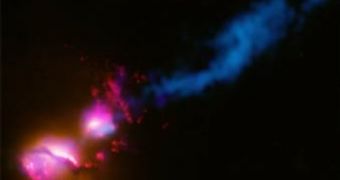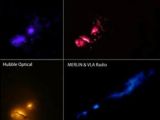The destructive jet particle emission is originated in the supermassive black hole situated in the center of the largest galaxy in the system, 3C321, and extends all the way to the closest galaxy about 20,000 light years away. This is the first jet particle emission observed originating in a galaxy and traveling all the way to the next.
Such emissions of matter are quite common in the universe, mostly observed in young forming stars and black holes as they 'feed' on surrounding matter. Accretion matter spinning around a black hole consists of ultra hot gas clouds glowing bright in most of the light spectrum. Eventually it will slowly start to collapse towards the black hole's singularity. However, though the black hole's gravity is extremely powerful, it cannot draw all the matter inside it, thus part of it will escape towards the black hole's poles being ejected into space.
The biggest particle jet ever observed, is approximately 1.5 million light years long. Nevertheless, this is the first time when scientists observe the phenomenon in which matter ejected in the form of jet particles extends all the way to another galaxy. Such an event pointing towards us would destroy the planet's atmosphere and trigger the star birth process in the wake of the deadly jet particle.
NASA named the galaxy the jet particle comes from the "death star galaxy" and it is part of a system 1.4 billion light years away, out of which it is the biggest, separated from its companions by a distance of 20,000 light years, equivalent to the distance from Earth to the center of the Milky Way.
Observations made with the Hubble Optical Space Telescope, Chandra X-ray Space Telescope and the MERLIN Radio Telescope revealed that the jet particles strike a punch through the edge of the smaller galaxy, resulting in a deflection of energy into the interstellar space. Usually these matter and energy jets contain extremely energetic particles and high levels of radiation, such as electrons traveling at relativistic speeds, X-ray and gamma-ray emissions, that would destroy the atmosphere of most planets present in its path.
For example, such high levels of X-ray and gamma-ray radiation could possibly destroy the Earth's ozone layer that protects us from the UV radiation from the Sun, in a mater of a few months, which will most likely trigger the extinction of the vast majority of species.
According to the astronomers involved in this study, the jet particle emitted from the central supermassive black hole could have probably reached the regions of the other galaxy about 1 million light years ago, and although it may seem that it will bring only destruction, actually, the smaller galaxy received high amounts of energy from its neighbor, which could help in the star and solar system formation process by compressing high quantities of gas clouds.
Martin Hardcastle of the University of Hertfordshire, believes that the supermassive black hole will continue to eject large quantities of matter and energy for at least another 10 to 100 million years, which should provide enough time to create new stars and solar systems.

 14 DAY TRIAL //
14 DAY TRIAL // 
